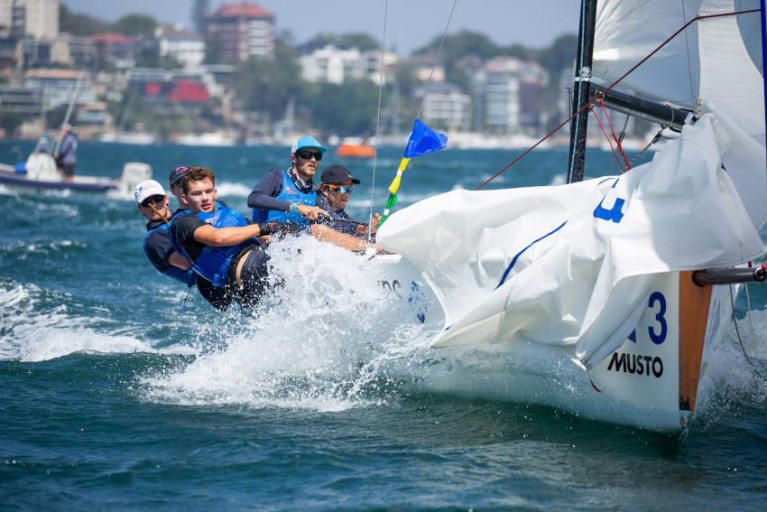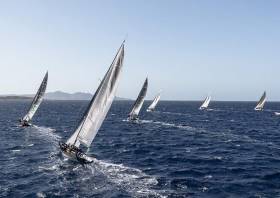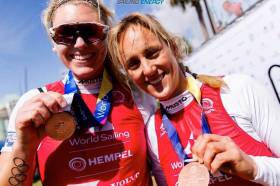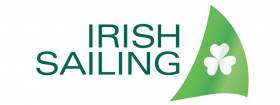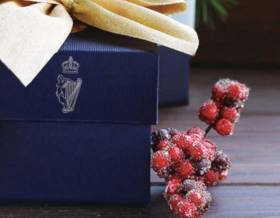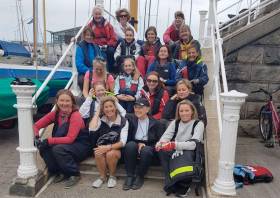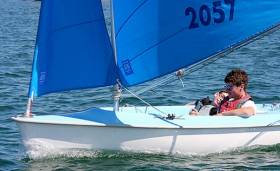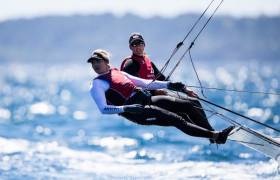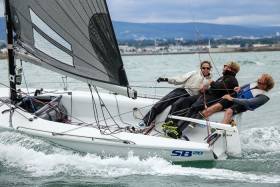Displaying items by tag: RIYC
Royal Irish YC Cadet Representing Dublin Club In New Zealand Hails Recent Sydney Match Racing Events
Royal Irish Yacht Club cadet member Niall Malone has sent the club an update of his recent competitions in New Zealand, where he currently lives and races.
First up was two weeks of racing in Sydney, Australia last month — at the Harken International Youth Match Racing Championships hosted by the Royal Prince Alfred from 18-22 November, and the Musto Youth Match Racing Internationals at the Cruising Yacht Club of Australia from 26-29 November.
“We had a good two weeks racing in a very close fleet in Sydney,” Niall says, hailing the “extremely high level of sailors” at both events.
Musto was his team’s first ever Grade 1 event, the helm says, so it was “a great opportunity just to be among such a good fleet and we were able to learn a lot”.
Despite neither event seeing him get the results hoped for, the young Irishman is proud that he “had some very close races, finishing less than half a boat length behind the world number two [New Zealand youth Nick Egnot-Johnson] and taking two wins of the Musto Youth International defending champion Frankie Dair”.
Next up for Niall will be the first ever New Zealand Foiling Match Racing Championships, being held at the Royal New Zealand Yacht Squadron from 13-17 January, in which he will be representing the RIYC.
Royal Irish Yacht Club Acquires Its Own Farr-Designed One Tonner
The Royal Irish Yacht Club has acquired a Farr-designed one-tonner for sail training and members’ use.
The club has credited the acquisition to the generosity of club member George Sisk, whose own Farr 42 WOW! has made an impact in Irish yacht racing for over 10 years.
The club says the high performance one-tonner, designed for both short course racing and offshore, “will greatly enhance [its] sail training offering for both novice and more experienced sailors”.
And it will also be available for charter by club members participating in club racing and offshore events.
Rear Commodore (Sailing) Jerry Dowling and RIYC member Tim Kane will give a talk about the club’s new acquisition and plans for 2020 on Thursday 14 November.
The talk from 7pm is free to members and their guests, followed by supper at €30 per head. All are welcome. See the RIYC website for booking or email catering for details.
This article was updated to correct that the yacht in question is not a Farr 40 as previously stated but a 40ft one-tonner designed by Bruce Farr.
The Royal Irish Yacht Club’s Saskia Tidey and her Team GB sailing partner Charlotte Dobson have launched a crowdfunding campaign to support their efforts to qualify for the 49erFX class in next summer’s Olympic Games in Tokyo.
The pair, who finished seventh among a strong field of contender at the 49erFX Europeans last month, say they have reached a “hurdle” in their present fundraising efforts.
“The level of financial backing we have needed to maintain podium positions has now exceeded beyond what our campaign budget is capable of.”
But with additional backing, they say, “we absolutely believe we can complete and deliver the training programme we have planned to bring home a medal”.
Saskia and Charlotte have set a £5,000 of which they have raised nearly a quarter in less than a week.
For more on the pair’s campaign, see their GoFundMe page HERE.
Read the pair’s full appeal below:
We are Olympians Saskia Tidey & Charlotte Dobson. Team mates onboard our 49er FX Olympic class skiff dinghy representing Great Britain on the British Sailing team. We need your help!
After the Rio 2016 Olympic games concluded we left with fire in our bellies and our eyes and hearts set on the goal to medal at the Tokyo 2020 Olympic Games in Japan.
For three years we have battled on the International World Sailing circuit to bring home medal winning performances for Great Britain. It has been a honour to fly the flag and and a privilege to be under the pressure of striving for greatness.
Unfortunately we have reached a hurdle in our campaign which we are finding increasingly difficult to jump. The level of financial backing we have needed to maintain podium positions has now exceeded beyond what our campaign budget is capable of. With additional funds we absolutely believe we can complete and deliver the training programme we have planned to bring home a medal.
This summer we will represent Great Britain at the 2019 Olympic Test event in Japan. Please follow our journey and donate before August 2019 to help us reach the gold standard program we need to continue to succeed!
With Tokyo 2020 just around the corner we are seeking help and support from anyone would would like to join our journey and help us keep on the podium for Great Britain in 2020!
Sailing is a sport that can be overlooked and misunderstood but it is an exhilarating sport which is accessible to everyone and we would love to entice more viewers to enjoy it too!
Please help us on on our journey!
Follow our story on Instagram @gbr_44fx
Help Spread the word!
Charlotte & Saskia xox
Irish Sailing Hosts 2019 AGM On 30 March
Irish Sailing will hold its Annual General Meeting for 2019 at the Royal Irish Yacht Club from 11am next Saturday 30 March.
The agenda will include minutes of the AGM of 10 March 2018, reception of the president’s report, and consideration of the company’s financial statements and auditors’ reports for last year.
There will also be an election of directors and the president of the board, who is elected annually in accordance with Article 57.
The full notice of Irish Sailing’s 2019 AGM is attached below.
The Royal Irish Yacht Club looks forward to welcoming Kevin Vickers, the Canadian Ambassador to Ireland, as its international guest speaker at a dinner next Friday 9 November.
Ambassador Vickers has served as Ambassador of Canada to Ireland since January 2015. He was previously Sergeant-at-Arms of Canada’s House of Commons and prior to that had a successful 29-year-long career with the Royal Canadian Mounted Police (RCMP).
He is a recipient of the Queen’s Jubilee Medal, the Canada 125 Medal, and the RCMP Long Service Medal. He has also been recognised by the Community of Burnt Church for his outstanding service to their community, and by the United States Drug Enforcement Agency for his ‘Outstanding Contribution to Drug Enforcement’.
In 2014, Vickers was hailed as a hero by Canada’s parliamentarians and other prominent Canadian and international figures for his actions in stopping the October attack at the Parliament of Canada.
This event is open to all RIYC members and their guests and will cost €40 per person including a glass of Prosecco on arrival. A members’ table will be available. Online booking is available HERE.
Another date for your calendar is Thursday 22 November, when the RIYC Military History Annual Lecture is delivered by keynote guest Professor Saul David, well-known British academic military historian, author and broadcaster.
Prof David will deliver his lecture ‘The Force: The First Special Service Force and the Capture of Monte la Difensa’, telling the incredible true story of the assault on Hitler’s Winter Line in southern Italy in December 1943 – one of the greatest military feats of the Second World War – and the small group of elite US and Canadian soldiers who carried it out.
As previously reported on Afloat.ie, the RIYC’s Christmas brochure details events planned at the Dun Laoghaire waterfront clubhouse throughout the upcoming festive season.
A Festive Selection For Christmas At The Royal Irish Yacht Club
The Royal Irish Yacht Club has released its 2018 Christmas brochure, detailing events planned for the upcoming festive season.
Clubhouse dining options begin on Saturday 1 December and include a family lunch on Sunday 9, and a special seven-course ‘Taste of Christmas’ menu on Saturday 15.
Members can also enjoy an evening of carol singing with the Ryan family on Monday 10 December, with mulled wine and mincepies before supper in the dining room.
And for the younger members, Santa Claus himself will be visiting the club — but be sure to book your spot at the Wet Bar.
Royal Irish Ladies Make A Day Of It On Dublin Bay
#RIYC - The women of the Royal Irish Yacht Club filled four 1720s for two great races on Dublin Bay as part of the club’s Ladies Race last Friday 27 July.
Conditions were challenging with gusts of up to 25 knots, but that’s nothing these women can’t handle — particularly Gill O’Connor, who did a top-notch job organising the day having just had a baby three weeks ago.
Michael Tyrrell also served as race officer for the day, which is hoped to become an annual fixture on the Royal Irish calendar.
Dun Laoghaire Sailability Programme Returns For 2017
#Sailability - Dun Laoghaire’s waterfront clubs have launched their 2017 sailability programme for children ages 8-17 with physical and/or sensorial disabilities.
The programme kicks off with a try sailing event on Sunday 11 June at the Royal Irish Yacht Club, with morning sailing proper commencing at the Royal St George on Sunday 18 June, continuing each week (except 9 July and 6 August) till 20 August in conjunction with the Dun Laoghaire Motor Yacht Club.
There will also be two week-long sailing courses, provided by the National Yacht Club (12-16 June) and the Royal Irish YC (8-11 August).
No sailing experience is necessary to take part in the sailability programme, sponsored in 2017 by the Spirit Motor Group Volvo Ireland and the Water Wag sailing class, among others.
For general enquiries and further details, contact Ian French (087 245 6834 or [email protected]) or
Ruth Shanahan (086 237 4801 or [email protected]).
Saskia Tidey’s enthusiasm for racing the 49erFX to Olympic level is such that after she’d exhausted every possibility of finding a sailing partner towards Tokyo 2020 within Ireland, she had to cast the net towards the UK, and linked up with Charlotte Dobson.
Dobson had finished 8th in the 2016 Rio Olympiad sailing with Sophie Ainsworth. Ironically, Charlotte Dobson is also an “outsider”, as she’s from Helensburgh on Scotland’s Firth of Clyde, and went to university in Edinburgh. But whatever their background, and whatever the national colours they’re now sailing under, their first major international debut at the Hyeres championship – after just four months training together – was an immediate breathrough, as they took the Bronze Medal.
By any standards it was a remarkable achievement, after just four months of shared training it was phenomenal, and Saskia Tidey of the Royal Irish Yacht Club is clear winner of our “Sailor of the Month (Olympic)” Award for April 2017.
Royal Irish Yacht Club Regatta 2016 Results & Photos
27 classes competed in today's Teng Tools sponsored Royal Irish Yacht Club Regatta on Dublin Bay. Having just finished the Round Ireland Race on Thursday, the club's own JPK1080 Rockabill VI (Paul O'Higgins) was back on the water again, winning the 18–boat IRC one division. Full results in each class are downloadable below.


























